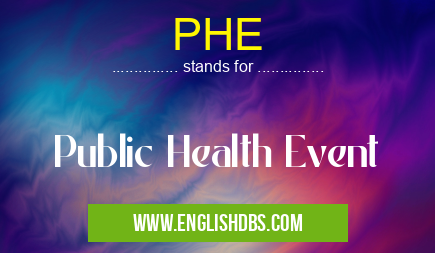What does PHE mean in HEALTHCARE
PHE stands for Public Health Event. It is a situation or occurrence that poses a significant risk to public health, requiring immediate action to prevent or control the spread of disease or injury. PHEs can range from localized outbreaks to global pandemics.

PHE meaning in Healthcare in Medical
PHE mostly used in an acronym Healthcare in Category Medical that means Public Health Event
Shorthand: PHE,
Full Form: Public Health Event
For more information of "Public Health Event", see the section below.
» Medical » Healthcare
Types of Public Health Events
- Communicable Disease Outbreaks: These occur when an infectious disease spreads rapidly within a population, such as influenza, measles, or COVID-19.
- Environmental Health Emergencies: These involve threats to public health caused by environmental factors, such as natural disasters, pollution, or chemical spills.
- Animal Health Events: These include situations where animal diseases pose a risk to human health, such as rabies or zoonotic infections.
Response to Public Health Events
Responding to PHEs requires a coordinated effort involving public health agencies, healthcare providers, and emergency responders. Common response measures include:
- Surveillance and Monitoring: Tracking and monitoring the spread of disease or injury to identify trends and potential outbreaks.
- Epidemiological Investigation: Determining the cause and extent of a PHE to develop appropriate control measures.
- Control and Prevention: Implementing measures to prevent or stop the spread of disease or injury, such as isolation, quarantine, or vaccination.
- Public Health Communication: Providing accurate and timely information to the public about PHEs to promote awareness and encourage preventive actions.
Essential Questions and Answers on Public Health Event in "MEDICAL»HEALTHCARE"
What is a Public Health Event (PHE)?
A PHE is a situation that can have a significant impact on the health of a community or population. It can be caused by a variety of factors, including natural disasters, disease outbreaks, or chemical spills.
What are the different levels of PHEs?
PHEs can be classified into different levels based on their severity and impact. The most common levels are:
- Local: Affects a specific area or population
- State: Affects an entire state
- Federal: Affects multiple states or the entire country
- International: Affects multiple countries
What are the signs and symptoms of a PHE?
The signs and symptoms of a PHE can vary depending on the type of event. Some common symptoms include:
- Increased illness or death
- Disruption of essential services (e.g., water, electricity)
- Damage to infrastructure
- Social unrest
What should you do if there is a PHE?
If there is a PHE in your area, it is important to follow the instructions of local authorities. This may include:
- Evacuating your home
- Seeking medical attention
- Staying informed about the situation
- Taking steps to protect your health and safety
How can I prepare for a PHE?
There are a number of things you can do to prepare for a PHE, including:
- Having an emergency plan in place
- Stocking up on essential supplies (e.g., food, water, first aid kit)
- Staying informed about potential hazards in your area
- Getting vaccinated against common diseases
Final Words: PHEs are significant events that can impact public health and well-being. Effective response to these events requires a multidisciplinary approach, involving collaboration among public health professionals, healthcare providers, and emergency responders. By implementing prompt and appropriate measures, PHEs can be controlled and their impact on public health can be minimized.
